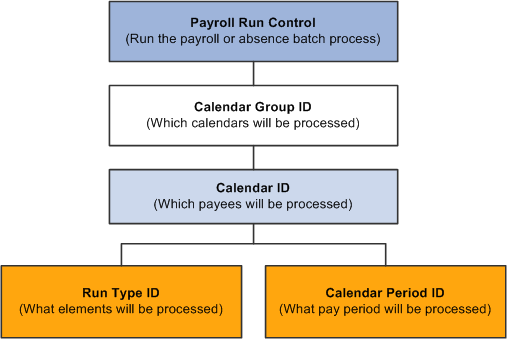Understanding Calendars
This topic lists common elements and discusses:
Calendar pay process flow.
Creating calendars.
Field or Control |
Description |
|---|---|
Calendar |
Identifies which payees to process and the run type and pay period. It can include instructions for generation control, excluding certain elements from processing, overriding supporting elements, and providing other information. |
Calendar Group |
When you start a payroll or absence process, you must enter the calendar group ID that identifies the calendar or set of calendars to process, or in the case of off-cycle runs, the set of off-cycle groups to process. You can process multiple calendars or off-cycle groups simultaneously. Calendar groups are keyed by country, so you can include multiple calendars or off-cycle groups for the same country in a single calendar group. |
Period |
Defines the pay period and frequency for your processing run. You attach a pay period to a pay run by linking it to a calendar. Like run types, pay periods are reusable. |
Run Type |
A user-defined method of identifying a payroll or absence run. Common run types are regular, bonus, overtime, and advance pay. The run type identifies the process list to use, whether to process retroactive triggers, and information needed when processing data from Time and Labor or the Manage Variable Compensation application of HR. It's also used in generation control, historical rules, and retroactive matching processes. You attach a run type to a pay run process by linking it to a calendar. Because you define the run type information outside the calendar, you can link the same run type to multiple calendars. For example, if a weekly and a monthly pay group use the same process list, you might set up one run type and link it to multiple calendars. The effective date enables you to switch process lists or retroactive trigger processing actions and yet reproduce a retroactive calculation with old settings. |
When processing a payroll or absence run, the system must determine which payees to process; what earnings, deductions, and other elements to process for selected payees; and what time period to process.
For on-cycle processing, calendars unify this information. Calendars link the components that tell the system whom and what to process for which pay period.
Note: With off-cycle processing, off-cycle groups, rather than calendars, identify which payees to process, the elements to process, and the time period.
This diagram illustrates how components interact to produce an on-cycle payroll or absence batch processing run.

Calendars bring payees in a selected pay group together with the rules and processes for calculating a payroll or absence run. You can define calendars by:
Defining a single calendar with the Calendars component.
When you define a calendar with this feature, you can enter instructions for generation control, overrides, or elements to exclude from processing. You can specify the period for which to retrieve payable time from Time and Labor.
Using the Automatic Calendar Creation component to define multiple calendars simultaneously.
You can use the Calendars component to edit an automatically generated calendar.
Note: Before you create calendars you must define the run type and period ID associated with the calendar.
See Prerequisites.